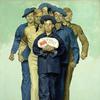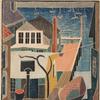World’s Most Significant Exhibition of American Indian Chilkat Blankets Debuts in Santa Fe August 17-20
- SANTA FE, New Mexico
- /
- July 30, 2015
The world’s most extensive exhibition of American Indian Chilkat Dancing Blankets and their predecessor, Raven’s Tail weavings will be on view at The Antique American Indian Art Show in Santa Fe from August 17-20. Chilkat Blankets: Artistic Masterpieces will present more than a dozen historic and contemporary blankets and two complete ceremonial ensembles. The Chilkat blankets on view collectively represent the finest examples of these unique art forms, in the world. Chilkat and Raven’s Tail blankets are experiencing an artistic tradition revival, and are now being woven in the North West Coast and Alaska.
The Origin of Chilkat Dancing Blankets:
According to myth, the first Chilkat Dancing blanket was created by daughter of a great chief. She had gotten lost while foraging in the woods and met an incredibly handsome man. She agreed to go with him, but found out he was a member of the Bear Clan (a rival to her own).
One day, she escaped from the village of her spouse and saw a fisherman in his canoe, on the water. She called out to him for help. After hearing her tale, he agreed to take her away, but only if she would become his wife. She got into his canoe just as her Bear husband came out of the woods. The canoe sped off. It was then that she discovered that her rescuer was not human; he was the benevolent sea spirit “Gonaqadet.” They lived happily in his home under the sea for many years. They had a son, and when that son was of age to learn the arts of men, his mother took him to the land of her brother. Her son learned how to hunt, and fish, make tools and dance. During this time Gonaqadet’s wife began weaving. She created a magnificent ceremonial robe that told of the meeting of her husband and their courtship. When her son became of age, she left the land and went back to her home under the sea. She presented her husband with the robe. This was the first Chilkat Dancing Blanket.[1]
A traditional form of weaving, Chilkat Dancing blankets were made by the Haida, Tsimshian & Tlinget people of British Columbia and Alaska. Labor intensive, Chilkat blankets were prized for their craftsmanship and worn during ceremonial dances. These complex textiles are the most recognizable of all North West Coast American Indian artforms.
The blankets were worn or used on ceremonial occasions, including the potlatch, which included speeches, feasting and dancing…and ended with the host’s presentation of the privileges he claimed, which were validated by gift-giving. Only the wealthiest chiefs were able to give Chilkat blankets to distinguished guests, in entirety, or cut into strips and distributed at a potlatch. These intricate blankets were so prized, that guests who had received a piece of Chilkat blanket would sew the fragment into a piece of clothing like an apron, leggings or tunic. Some collections contain such items made from one or more pieces of Chilkat blanket.
Why are Chilkat Blankets so Unique?
Chilkat or dancing blankets take in excess of one year to create. A multi-stepped process, the blankets required much planning: from harvesting materials, to produce the yarns, garhering the mountain goat wool, creating a pattern board, and finally weaving. Traditionally, Chilkat blankets were woven of mountain goat wool and yellow cedar bark. Preparation of the fibers was time consuming. Only the ‘down’ of the mountain goat hair was used. The cedar bark was collected, dried, split and wet, then combined with the mountain goat wool. ‘Spinning’ the wool was accomplished by rolling the wool using bare hands Dye was produced from natural sources including tree lichen, copper or hemlock and set with aged urine. Preparation of the materials could take more than of 6 months. Materials in hand, the actual weaving of the blanket would take many months more. Blankets were often finished with fine fringe.
Chilkat blanket designs are abstract in nature, and quite complex. The pattern was created by an artist on a ‘pattern board’, which the weaver would use to make the blanket. These patterns frequently contained the same design elements seen in masks, carvings and paintings.
Only a few master Chilkat weavers existed in each tribe. And, not everyone was allowed the right to wear a blanket. These rights were passed down from clan member to clan member.
By the mid 1950s there were only a very few living Chilkat weavers. Colonization had severely affected the First Nations communities in Canada and the Native American community of Alaska. Consequently many of their traditional arts were becoming more and more rare.
Ravens Tail weaving had all but disappeared, and was only recently rediscovered by the academic Cheryl Samuel, who learned of the technique and design while researching her seminal book The Chilkat Dancing Blanket. Cheryl Samuel began teaching Chilkat weaving in Alaska and Canada to native weavers. One of her works will be on view in the exhibition.
A new dawn for Chilkat Weaving: Clarissa Rizal
Clarissa Rizal, from the Tinglit tribe of Alaska, is one of the new group of Chilkat weavers. She is committed to keeping the Chilkat tradition alive for future generations. Two full ensembles by Clarissa Rizal and her daughter Lily will be on view in the Chilkat Blanket: Artistic Masterpieces exhibition. Clarissa was taught by Jennie Thlunaut, a master weaver, who also wove with Cheryl Samuel.
The Antique American Indian Art Show takes place at El Museo Cultural de Santa Fe, 555 Camino de la Familia, Santa Fe, NM 87501. The show opens with a benefit for New Mexico PBS on Monday, August 17th. Public Hours are Tuesday August 18th - Thursday August 20th from 11am to 6pm. Tickets are $15 or $20 for Joint Admission to Antique American Indian Show + Objects of Art Santa Fe. For additional information, including a complete list of exhibitors, or to purchase tickets, visit www.AntiqueIndianArtShow.com. Public inquiries, please call 505.660.4701.
[1] Samuel, Cheryl, 1982. The Chilkat Dancing Blanket, University of Oaklaholma Press, p 12-15.
Contact:
Agnes Gomes-KoizumiAGK Media
agnes@agkmedia.com
agnes@agkmedia.com
















